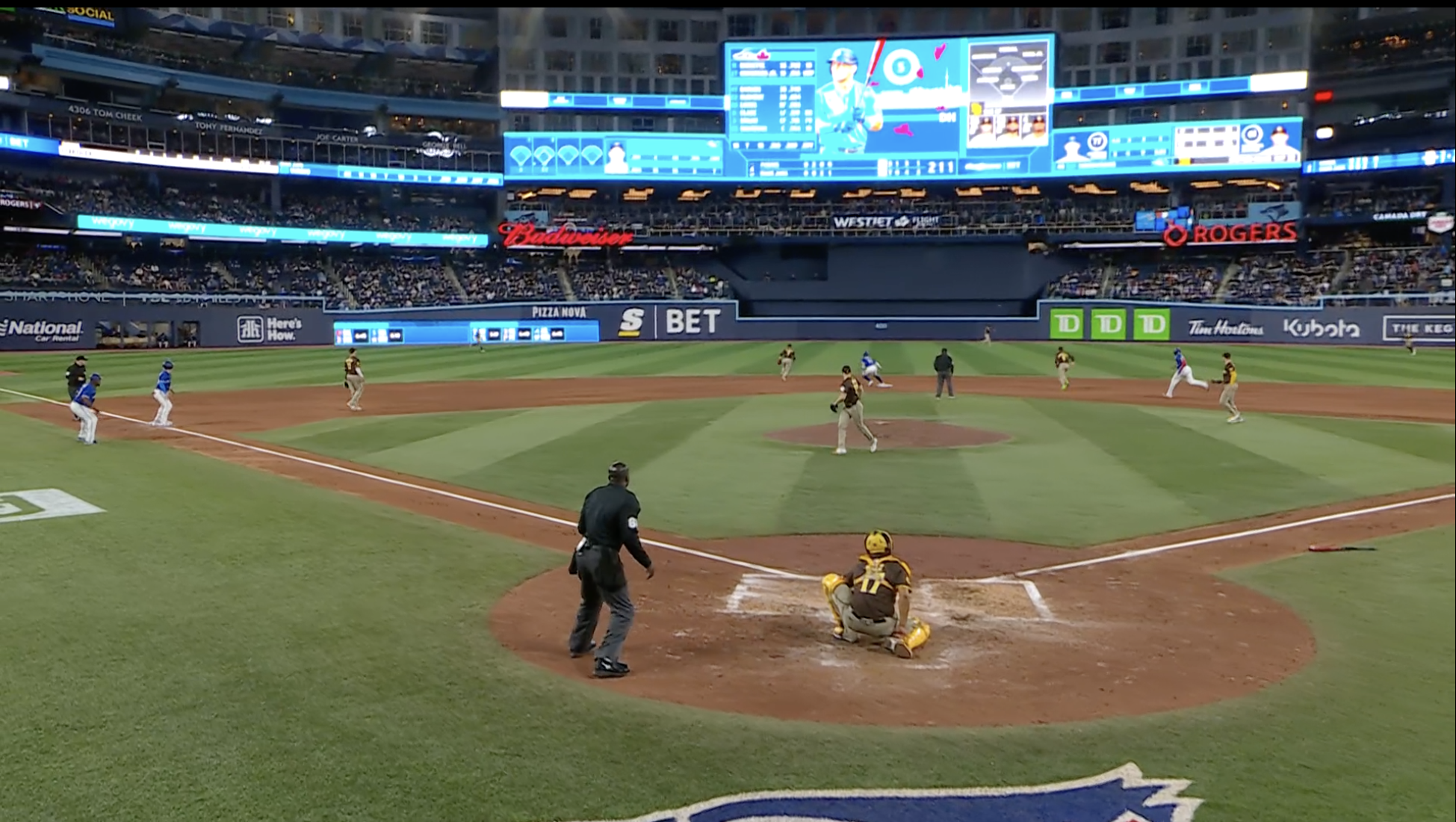
Various members of the Toronto Blue Jays either tag up, or don't, while they wait for a line drive to be caught in the outfield in a game against the San Diego Padres. Okay, so there's a lot going on, here. First of all, to get a bigger look at this shot, click here. So, what we have here is a line drive off the bat of Daulton Varsho (not pictured), being tracked down by center fielder Jackson Merrill (visible, but only barely). Meanwhile, Tyler Heineman tags at third, while Bo Bichette tags briefly at second. Last but not least, you can see Vladimir Guererro, Jr. realizing that he should probably tag up as well. To be fair, the ball off the bat looked like it had the potential to fall for a hit; to see the full play, click here.
Tagging Up
When there’s a runner on base, and the batter hits a ball in the air, the runner is not allowed to attempt to advance until the ball is touched by a defender. Most of the time, the first touch is simultaneous with the ball being caught, so it’s useful to think of it in similar terms: when the ball is hit in the air, runners cannot advance until the ball is caught.
Most baserunners are already off their bases when a pitch is thrown; this is known as "leading off." This means that when the ball is hit in the air, those runners need to go back to their base while the ball is in flight; this process is known as “tagging up”. A runner doesn’t necessarily need to tag up before the ball is caught (or touched), but again, they cannot advance until they have tagged up. In practice, this means that runners will make their way back to the base, and stay there until the ball is caught (or touched). Depending on where the ball is hit1, the defensive acumen of the player who catches it, and the speed of the runner, that runner might try to attempt to advance once the ball is caught— especially if they’re starting from third base2, and the ball was hit deep enough that they can score. This specific play is referred to as a “sacrifice fly” because the batter sacrificed their plate appearance to allow the run to score. A runner who tags up and attempts to advance is subject to being tagged out under normal tag out rules.
And if a batter doesn’t tag up? Well, if a runner doesn’t get back to their base quickly enough, or if they do tag up, but leave the base early, the defense has a chance to get that runner out. To do so, they need to get the ball to the base before the runner has the chance to get back. The mechanics here are much like a force play; a defender has to be in control of the ball, and touching the base in question, before the runner gets back to tag. Similarly, after a tag up play is over, and the defense thinks a runner left their base too early, they can make what’s called an “appeal” to the umpire who is in charge of the base. Specifically, before the next pitch is thrown, the pitcher steps off the rubber, and throws the ball to the base in question, where a fielder will catch the ball and tag the base. If the umpire agrees that the runner left too early, that runner is called out. If that runner scored, the run (and the sacrifice fly) are negated. An out call for bad tagging-up can also wipe out unrelated runs if it is the third out of the inning. Because tag-up plays often involve some very close timing between two events that aren’t very close to one another, a team will often have to resort to a replay review to get the call they’re looking for.
For your standard medium-to-long distance fly balls, runners will typically have more than enough time to go tag up, and potentially advance. But if a runner takes off on a stolen base attempt, and the batter hits a screaming line drive right at an infielder? Yeah, the runner is probably toast.